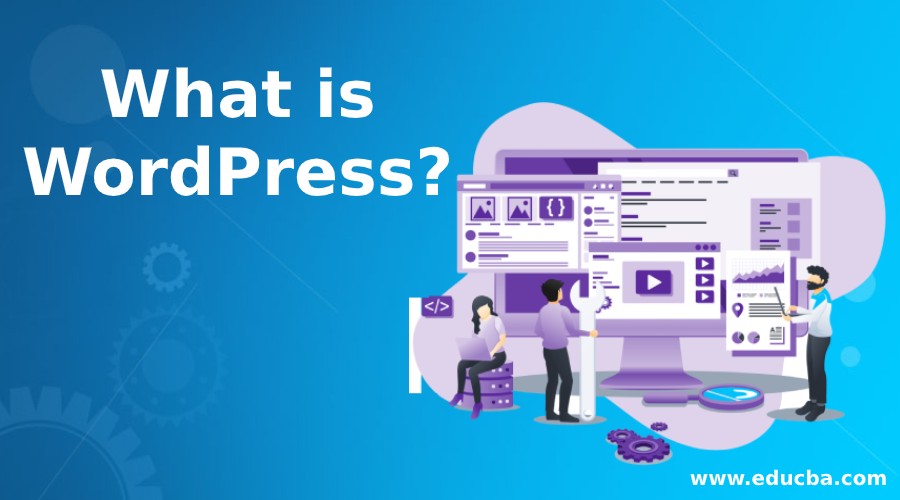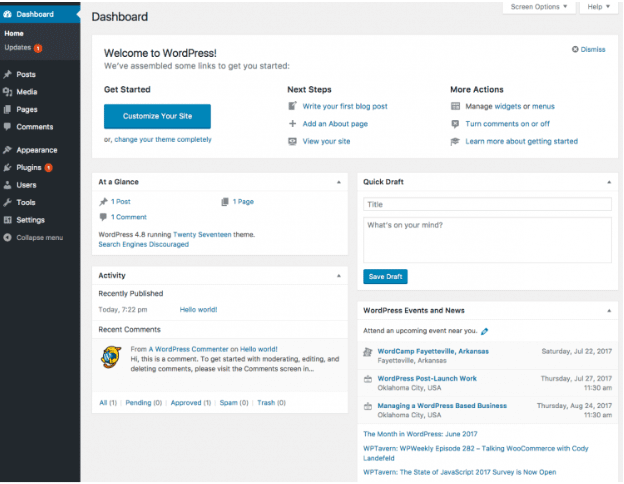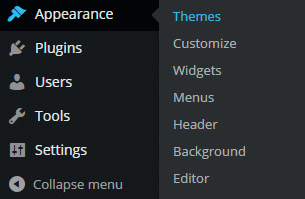Introduction to WordPress
WordPress is a content management system developed using PHP and MYSQL (which themselves are also open source in nature), used to develop a website, blogs, simpler to the most complex with ample customization options, and can be incorporated into business at a nominal cost. A web-based user interface is provided for designing websites and publishing them. WordPress is a content management system, open-source in nature and based on PHP & MYSQL. WordPress can help you build anything from the simplest blog to a complex professional-level website. As per wordpress.com, 33% of the websites on the internet are powered by them.
Now, why did people stop tethering to their previous approaches and start going all the way with WordPress? The answer is that if you are a new developer or have a novice set of computer hobbyists, or you are about to host a low-budget project where you need to provide a great experience to your customer and external stakeholders accessing the website, then WordPress is a most comfortable platform as it cuts development time, provides content management system so that clients can add content on their own. Bloggers need not be technical to add content. And it’s not like a WordPress agency with a track record of successful digital publisher projects can’t help make your website unique and scalable.
Thousands of free WordPress themes are available for incorporation into the website to be designed by you; you can also modify the themes, thereby keeping your website’s theme unique from generality. Hence, you are open to designing and developing any e-commerce, forum, portfolio, etc.
Understanding WordPress
- Before heading forward, let us understand the difference between a blog and a website. The website consists of many pages and is not updated frequently, while blogs are dynamic in nature, updated more frequently; hence one can say that blog can be a part of the website, but the website cannot be called a blog. Blogs may not be formal in nature, and users just interact here via comments.
- The next important point comes is how to host?
For the installation of WordPress, some online space will be required, and you can choose for a supporting company; the hosting company would provide you with a one-click installation of WordPress. The other option is wordpress.com; also, it can also host your site if you are not looking to host your site externally from somewhere. For the business purpose, they charge near to $300.
If you are about to host through WordPress, then you can only use their themes, and custom plugins are not allowed.
The next step comes is website planning, so now you should think about how to handle the following things carefully:
- How will be your home page structure and what the tabs and trees would contain.
- Which plugins will be supported if you are thinking to incorporate any into your website.
- Domain name selection and backup for the website.
- Payment gateways, easiest is to choose Paypal.
- What amount of traffic your website can likely face in the worst case.
Explore what WordPress has to Offer us
Given below shows what wordpress has to offer us:
1. Dashboard – components placed in the website are managed via this dashboard; you can do all customizations here like role assignment to users, website layout changes, any behavioral changes, etc.
2. Admin Bar – You can see the admin bar in black color; by hovering over this, you can visit the site, update plugins, and admin details can be seen.
3. The sidebar in the dashboard contains many options, and they are elaborated
- The posts section is used to edit, add or delete posts on websites.
- Media can be used to add any files like video.
- Pages can be used to add new pages to the site, or the existing pages can be updated too.
- Comments can be handled, i.e. trashed, approved, or spam.
- The appearance section deals with the layout of the website.
- The plugins section helps to manage the plugins, either existing or new ones to be introduced.
- Users section is used to do CRUD operations on the user.
- Tools can be used to incorporate any external tool into a website.
- The settings section handles content management which we have been talking about till yet.
- The collapse section, when hit, hides the sidebar.
4. To add themes navigate to Appearance in the dashboard and then click at themes
Then, upon clicking at themes, you can choose to add a theme option to incorporate your desired theme ( can also be uploaded from external resources). After the installation of the theme, it gets applied, and now you get redirected to the new page. By using synonymous options, the themes could be deleted.
5. In the same way, the desired widgets can also be added
6. Now the point comes, how to create pages
Steps to do this are simple:
- Log in to your WordPress as an administrator.
- Again the dashboard’s sidebar carries an option of pages; once you hover there, you can see all pages or add a new one.
- On adding the page, you need to give the content and do desired to edit as required thereafter; you can publish it.
7. Now, let’s see how to create posts
- Again access the dashboard, and there appears the option of a post; you can write that post and publish it.
- Note that there is an option to add media at this screen; here also users can upload media either from the system or from the media library.
- Similarly, videos can also be added, you just need to paste the link of videos you browsed over the internet to the editor, and then you can easily publish it.
- The HTML code can be added too.
- Audio can also be a possible media type.
- The posts you added can also be categorized using the Category option in the sidebar of the dashboard.
- The next thing that comes is plugin installation; you would be knowing that plugins are helpful in functional expansion of the website, so go to dashboard again, click on Plugins this time and add new, now you can search the kind of plugin you want to have from the search box. After the installation of the plugin, it has to be enabled.
How does WordPress Work?
- WordPress has three directories – wp-admin, wp-content, and wp-includes.
- The wp-admin and wp-includes directories include core WordPress files that shall not be edited ever. The themes, plugins, media, etc., are placed in the wp-content directory. If you alter any of the core files, then it will result in an unstable website.
- There is a wp-config.php file in the root directory of WordPress; this file incorporates the database connection details.
- Setting the WPLANG option value sets the default language for WordPress. A corresponding Machine object file shall also be installed at wp-language/languages for the language selected.
- The machine object files are compressed portable object files, which contain translations for WordPress messages and text strings in specific languages.
- In the wp-config file, some advanced options are available to set the WordPress address and blog address.
define (‘WP_SITEURL’, ‘http://facebook.com/wordpress’);
define (‘WP_HOME’, ‘http://google.com/wordpress’);
- WP_PLUGIN_DIR,WP_PLUGIN_URL are used by plugin developers to determine where the plugin folder resides.
- The post revisions can be maintained using the WP_POST_REVISIONS option ( post revisions help to keep records limited). There is an AUTOSAVE_INTERVAL option
To autosave these revisions periodically, that time has been set to 60 seconds.
- Debugging errors in WordPress can be done by the WP_DEBUG option; enabling this option actually shows up errors on screen rather than suppressing them; you just need to set the value to true to enable it.
define(‘WP_DEBUG’,true)
- SAVEQUERIES is also counted as one of the debugging options; activating this option will save all database queries into the global array that can be displayed on the page.
- Memory limit can also be set in WordPress using the WP_MEMORY_LIMIT option; the website cannot cross the memory limit; else an error will be thrown.
define(‘WP_MEMORY_LIMIT’,8M)
- Now how to manage cookies? There are multiple cookie options like COOKIE_DOMAIN, COOKIE_PATH, SITECOOKIEPATH.
Define(‘COOKIE_DOMAIN’,’ name of the domain’)
Define(‘COOKIEPATH’,’/’)
Define(‘SITECOOKIEPATH’,’/’)
- The .htaccess file is there, which is used to create pretty permalinks and keyword injected URLs for the website.
- .maintenance file of WordPress is used for maintenance mode.
Functions.php – this file contains the main WordPress API functions, plugins, themes, and WordPress core uses these functions.
- Current_time – retrieves the current time based on type.
- force_ssl_login – requires https SSL for login into WordPress.
Formatting.php – this file contains the WordPress API formatting functions; they format the output in a different way –
- wp-special chars – used to convert characters to HTML entities
- esc-attr – this is used to clean string containing HTML
Plugin.php – this file contains WordPress plugin API functions like:
- add_filter – hooks that the wordpress core launches to filter content before displaying that at the screen.
Post.php– this file contains the functions used in wordpress’ post-process, this uses:
- wq_insert_post – this creates a new post.
- get_posts – retrieves the latest posts.
Category.php – this file contains the functions used by the wordpress category API.
- get_categories – used to retrieve an array of category objects based on parameters.
- get_cat_ID – returns category ID from its name.
What can WordPress do?
- In the modern development era, where you have a wide variety of stakeholders with a variant set of diverse needs, it’s clear that any tool that is well equipped with ample features and is simple for the developer would suffice.
- WordPress can help you build websites at nominal costs of hosting for business.
- Startups with low venture capital can easily target this tool.
- You can customize your websites at any time with WordPress, similarly your blog posts, and you can publish those in real-time.
There are certain features mentioned explicitly at wordpress.com as follows:
- Easy to use
- Your own domain name.
- Outstanding design
- Mobile ready
- Best support
- Powerful statistics
- You can choose a plan among premium and business based upon features you require among those listed at wordpress.com.
Working with WordPress
When we look around this aspect, the primary things those shall be covered are:
1. Data Management – Default installation of wordpress has 11 tables, and they are as follows:
- wp_comments: Contains all comments in wordpress.
- wp_commentsmeta: Has metadata of comments.
- wp_links: Has links added through link manager
- wp_options: Stores website options appearing in settings
- wp_postmeta: Has post metadata
- wp_posts: Has all posts, records, and revisions
- wp_terms: Is responsible to correlate all the posts, links and so on.
- wp_terms_relationships: Joins the mentioned keywords above with content
- wp_terms_taxonomy: Defines the taxonomy assigned to each term.
- wp_users: Has website’s users
- wp_usermetadata: Has metadata for users.
2. Theme Development – Custom themes can be created via the help of a stylesheet and index.php template file.
There are other files like header.php, footer.php, sidebar.php, etc., for the same establishments.
3. Content Aggregation – It includes the social media buttons, advertising and pushing content from wordpress.
Advantages of WordPress
Given below are the advantages mentioned:
- Cheap product development can be done with this tool.
- Highly customizable.
- Provides ample features for website development and management.
- Any novice can take on and deliver a good product.
- Cost is genuine.
- Provides website hosting too.
- Provides pre-created theme templates.
- Handle SQL injection like threats in databases.
- It is an open-source framework.
- Certain files need to be manipulated for handling advanced changes.
Why should we use WordPress?
- You can create websites and blogs which look attractive and well structured in the easiest possible way.
- This tool dominates 33% of the website development market in the software industry as of now.
- It is easy to set up; with minimal effort, you can get the best results.
- There are proper channels for clients to have a look at the activities being performed.
- Content management is easily handled.
Why do we need WordPress?
- If you are developing websites from scratch, then for sure it is going to take your lot of energy into UI/UX designs, thereafter code development along with framework selection, but if you are not looking after all this overhead and just want to have blogs and webpages go live in the easiest manner, then wordpress is the correct choice.
- It not only provides you features like other frameworks on php provide, but some additional ones are there too. It is an interactive tool, and you can easily place your things inline.
- You can primarily focus more on your business outlook and business logic. WordPress will take care of extra overheads.
How will this Technology help you in Career Growth?
- If you are into freelancing, then for sure, you will have many clients who would offer you work on this platform.
- Small-scale entrepreneurs keep on looking for cheap and reliable technologies where they can put ample content and get their functionalities in line. They will probably need a payment gateway, too, so this would solve their purpose.
- Many php related startups are incorporating wordpress for development tasks.
- Content writers can place their blogs via the help of this.
Conclusion
WordPress is an open-source tool used for content management; you can maintain websites and blogs via the help of this, that too at cheap cost, novice developers or hobbyists can take on work at this.
Recommended Articles
This has been a guide to What is WordPress? Here we discussed the definition, need, uses, advantages, disadvantages of wordpress. You can also go through our other suggested articles to learn more –






